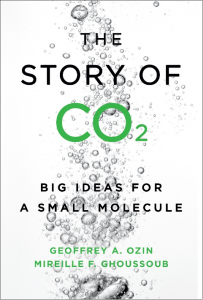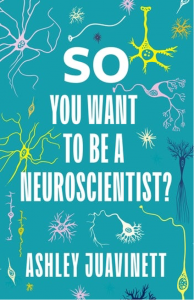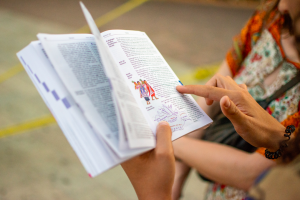Recently, I’ve become more curious about books as a form of science communication. In May, I reviewed a book about the science of Game Of Thrones for Massive Science. It prompted a few questions on my end. For example, how have scientists entered the world of book publishing? Was it intentionally, or was it an accidental journey? When do you decide that a single piece, such as a blog post or article, isn’t sufficient, and that a book format may work better? And, should scientists be considering books as a form of science communication more often?
To answer these questions, and a few more, I reached out to two scientists who published books during the COVID-19 pandemic. The first is Dr. Mireille Ghoussoub, who recently defended her PhD in materials chemistry at the University of Toronto, and co-authored a book, titled The Story Of CO2, with Dr. Geoffrey A. Ozin, her graduate supervisor. I also spoke to the author behind So You Want to Be a Neuroscientist?, Dr. Ashley Juavinett, who is an assistant teaching professor of neurobiology at the University of California, San Diego.
My first question was easy. What inspired these two scientists to write books in the first place?
 “I wrote the book with my PhD supervisor. He approached me towards the end of my first year of my PhD, and said ‘I have an idea, but it’s top secret. I want to write a book,’” says Ghoussoub. “He reached out to me and invited me to be his partner in book writing. It was a very impromptu journey, very unplanned, and the whole thing evolved over time. It wasn’t me waking up one day, having this realization: oh, I want to write a book.”
“I wrote the book with my PhD supervisor. He approached me towards the end of my first year of my PhD, and said ‘I have an idea, but it’s top secret. I want to write a book,’” says Ghoussoub. “He reached out to me and invited me to be his partner in book writing. It was a very impromptu journey, very unplanned, and the whole thing evolved over time. It wasn’t me waking up one day, having this realization: oh, I want to write a book.”
Geoffrey A. Ozin’s lab carries out research in the field of materials chemistry and catalysis, including carbon dioxide conversion. Ghoussoub remarks that their research felt very relevant, given the recent Intergovernmental Panel on Climate Change (IPCC) reports.
“We’re clearly facing a catastrophic climate change. We’re already dealing with the consequences. We know that to achieve our targets, it’s not a necessity to simply mitigate carbon emissions – we also need to remove excess carbon emissions, which are already in the atmosphere. There’s a whole world of carbon storage, capture and utilization that isn’t talked a lot about in mainstream climate discussions. Our book aims to introduce that concept to the toolbox of climate mitigation strategies, and we’re writing from the perspective of chemists,” says Ghoussoub. “My more realistic pitch is: ‘Do you want to nerd out and read a semi-textbook, with definitions in the margins?’”
On the other hand, for Juavinett, the editors at Columbia University Press reached out to her with an idea for a book in January 2018, as they had seen some of her online writing for Massive Science.
“Neuroscience is a new field – there’s no really good guide for students who are interested in it, while you can find similar things for biology, social sciences or general sort of PhD guides, but nothing really specific for neuroscience,” says Juavinett. “All neuroscience really had was this book from Santiago Ramón y Cajal, written in like 1906, which is more than 100 years ago, and is really a different world that he was living in. It’s still a book with a lot of really great insights, but it’s not applicable to students now.”
(The book by Santiago Ramón y Cajal is titled Advice for a Young Investigator.)
For Juavinett, this idea resounded deeply. The next step for her was to develop a full proposal for the book.
“What should be in such a book? What are the lessons we can take from Santiago Ramón y Cajal, but modernize them, for 2020? The book started taking shape, and after the proposal, I started writing,” says Juavinett.
 To inform her writing, Juavinett first dived into the current literature and reached out to different members of the science community, often through Twitter polls. Her book has four major parts, including an introduction to neuroscience as a field and how it has been growing over time, the ins and outs of graduate school, different aspects of research, and the many careers possible, including interviews from those currently in sectors such as academia, industry, science policy and writing.
To inform her writing, Juavinett first dived into the current literature and reached out to different members of the science community, often through Twitter polls. Her book has four major parts, including an introduction to neuroscience as a field and how it has been growing over time, the ins and outs of graduate school, different aspects of research, and the many careers possible, including interviews from those currently in sectors such as academia, industry, science policy and writing.
“The word count for this book ended up being close to 70K – a piece for Massive Science is probably around 1,000 words,” says Juavinett, with a laugh. “There’s certainly a big difference there. I feel like the biggest challenge that I faced in writing it was just holding it all in my head, in terms of: have I talked about this already? If so, where did I talk about this? Does it make more sense to talk about it somewhere else? Organizing all of these ideas in a way that sort of makes sense, is coherent, isn’t repetitive, but also is making links across the book to other parts of the book – I think that’s a real challenge.”
But how do you write a book…while carrying out research, or teaching, as a full-time career?
“This was a project dear to our hearts,” says Ghoussoub, describing how this was a four-year project, where she would often work on the book in short bursts. “But it was, as [my supervisor] reminded me throughout the process, this is a passion project. This was not my number one priority, as I [was] a graduate student too.”
For Juavinett, writing during the summers was key. “One thing that really helped me keep on task was [that] there were certain chapters that I thought would work well as a Medium piece. That really helped me keep on schedule, and made it a more digestible task […] taking it chunk by chunk was really helpful.”
In the third year of her PhD, Ghoussoub started cold-calling acquisition editors at different publishing companies in the mornings, before heading into the lab. Ghoussoub remarks that she got “incredibly lucky” while describing how she was able to connect to a recently hired science and technology acquisitions editor at the University of Toronto Press and pitch a proposal.
“Many publishing companies will accept pitches, or they’ll accept a written chapter,” says Ghoussoub. “By no means does someone have to have a complete manuscript to reach out to a publisher – but in our case, that’s more or less what we did.”
Similar to a manuscript, Ghoussoub’s The Story Of CO2 went through a peer-review process, where it was critiqued by three external academics over a five-month period, before undergoing copyediting and final technical touches, such as creating an index and obtaining permissions for images to be re-published.
“I’m so used to editing pieces that are 1,000 or maybe 2,000 words,” says Juavinett. “Doing that for a book – it turns out that it takes a lot of time. I very much underestimated this.”
Given that Ghoussoub and Juavinett have now written books, it begs the question: is this something that they would recommend to other scientists?
“I think that all ideas are worth writing about – you add the value to it. If there’s something that excites you, that’s worth writing about,” says Ghoussoub. “It’s so easy to find reasons to not write about something.”
“One consideration is the time that it takes, and the mental space that it takes,” says Juavinett. “For me, having a summer where my main objective was writing this book was super useful, because it meant that my cognitive load during the day was just dedicated to book writing. […] If you’re working full-time, sometimes it’s hard to find that energy after work, especially if you do a very cognitive heavy job.”
A second factor is passion. Juavinett notes that making the PhD process very explicit was important to her, which helped her to find the energy and space to write this book. That being said, Juavinett says that single pieces can be just as impactful as a book.
“The people that will typically go to publishers and say that ‘I have an idea for a book’ are the people who are the most confident people in our society, and are more likely to be white males,” says Juavinett. “I would say that, especially if you’re from an under-represented population in science, or whatever your field is, if you have an idea for a book, you should write it. The voice really matters.”
“If I had gone back to my first-year self, I don’t know if I would have pursued it, had I known how much work it was going to be,” adds Ghoussoub. “But in retrospect, I’m really proud of myself for having gone through with it and accomplished it.”
Latest posts by Farah Qaiser (see all)
- Scientists turned book authors: insights into the world of publishing - December 3, 2020
- First ever ComSciConGTA held virtually this fall - October 8, 2020
- Opportunities for professional growth in your science career in 2020 - January 16, 2020







Comments